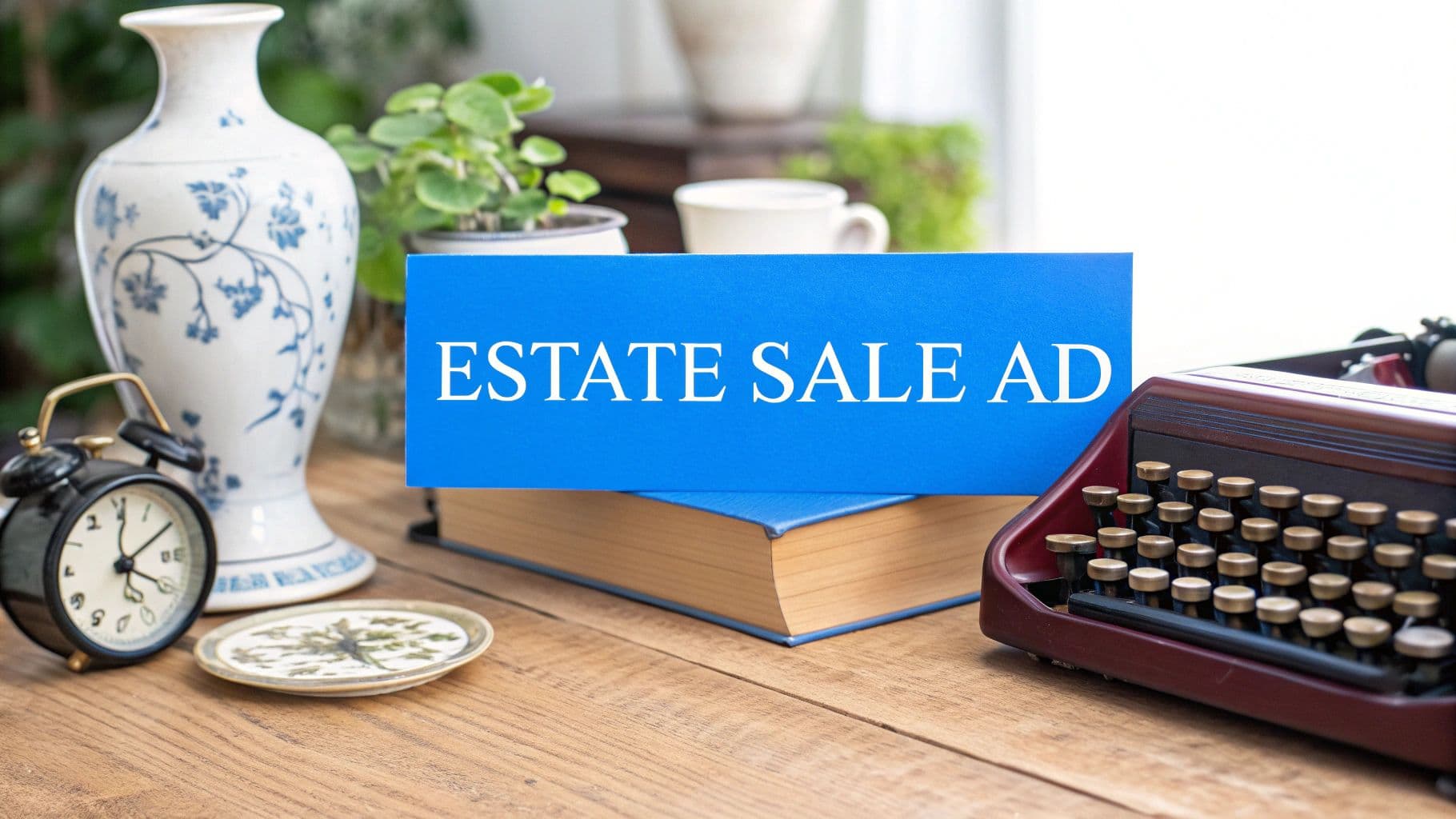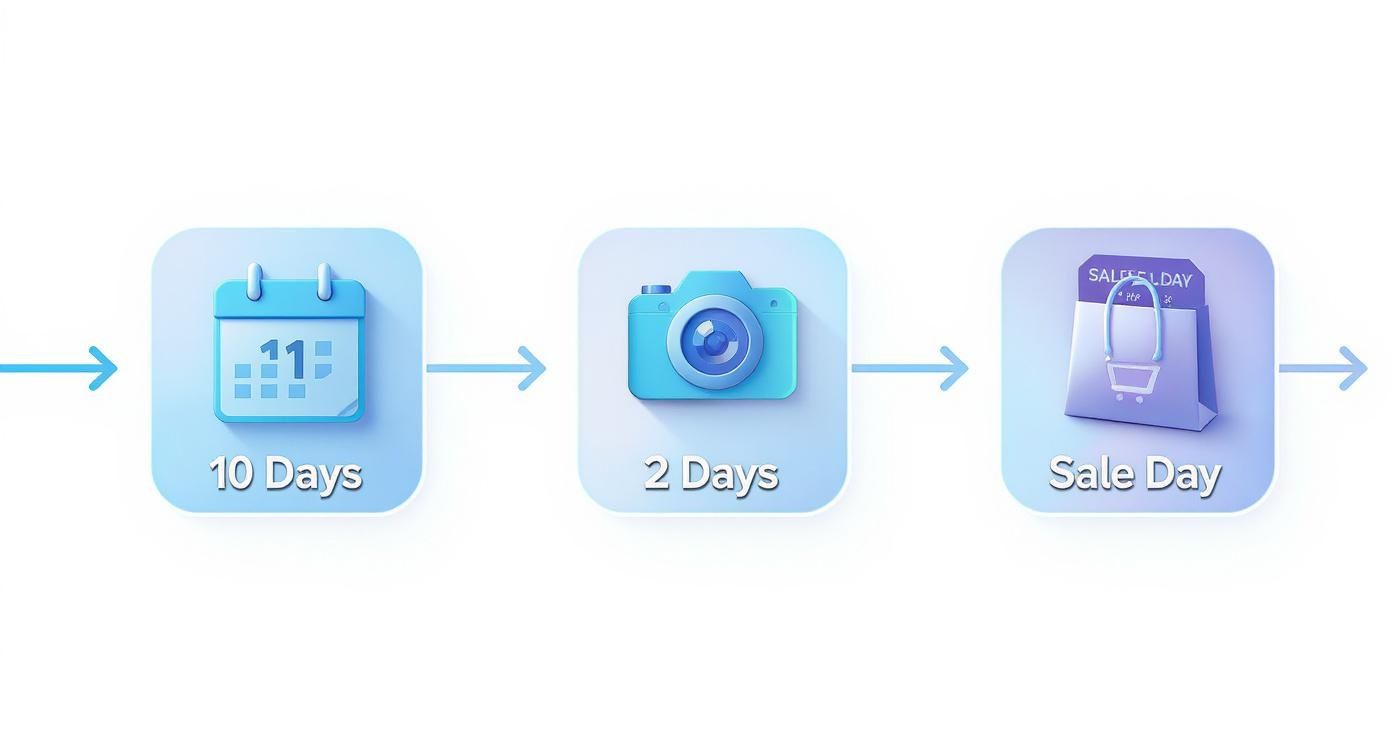How to Write an Estate Sale Ad That Sells Out

A great estate sale ad is so much more than a simple announcement of dates and times. It’s your secret weapon. A well-written ad creates a buzz, a sense of discovery that pulls people in and gets them excited to hunt for treasures at your sale.
This isn’t about just listing stuff. It's about blending a little bit of storytelling with the critical info, turning a boring classified into an invitation that bargain hunters and collectors can’t ignore.
Crafting an Ad That Captures Attention

Think of your ad as the foundation of your entire sale. It's the very first—and most important—tool you have for getting people in the door. If it doesn't stop someone mid-scroll, you've already lost them.
Let's ditch the generic templates. We need to focus on what actually gets people to show up. Every single word has a job: convince motivated buyers that your sale is the one they can't afford to miss this weekend.
Start With an Irresistible Headline
In a sea of listings, your headline is everything. It’s the bright, flashy sign on the street that makes someone slam on the brakes. A generic "Estate Sale This Weekend" is forgettable. You need something that immediately signals what’s special about your event.
Try one of these angles for a headline with some punch:
- Spotlight a specific collection: "Mid-Century Modern Collector's Estate Sale" or "Vintage Vinyl & Audiophile Equipment Sale." This instantly attracts niche buyers.
- Create a sense of urgency: "Everything Must Go! One-Day-Only Downsizing Sale in [Neighborhood]." This tells people they need to act fast.
- Lead with a showstopper: "Historic Home Estate Sale Featuring a 1974 Volkswagen Karmann Ghia." A unique, high-value item can draw a huge crowd on its own.
A powerful headline filters your audience from the get-go, making sure the right people see your ad and feel that twinge of FOMO (fear of missing out) if they don't click to learn more.
Weave a Compelling Summary
Once the headline has them hooked, the summary reels them in. This is where you tell a quick story. Was the previous owner a globe-trotter? A skilled woodworker? A passionate art collector?
Adding this touch of character gives the items context and a sense of history. It transforms a pile of "stuff" into a curated collection of treasures.
For instance, don’t just say "tools for sale." Try this instead: "Lifetime collection from a meticulous cabinet maker, including well-maintained power tools, hand planes, and exotic hardwoods." See the difference? It paints a picture. To really make your items stand out, it helps to learn how to write product descriptions that truly sell.
A great estate sale ad summary doesn't just list items; it sells the experience of discovery. It hints at the unique personality behind the collection, making shoppers feel like they're about to uncover something truly special.
Nail the Non-Negotiable Details
When it comes to the logistics, you have to be crystal clear. Any confusion is a reason for someone to skip your sale and go to another one. All the essential information needs to be presented in a way that's incredibly easy to find and understand.
To help you cover all your bases, here’s a quick-reference table of the absolute must-haves for your ad.
Key Components of a High-Impact Estate Sale Ad
| Component | What to Include | Why It's Critical |
|---|---|---|
| Full Address | Street, city, state, and ZIP code. | Shoppers need to map their route easily. An incomplete address is a major red flag. |
| Sale Dates & Times | List each day with specific hours (e.g., Fri 9-4, Sat 9-2). | Clarity prevents early birds and confused customers, ensuring a smoother flow of traffic. |
| Payment Methods | Cash, credit cards, Venmo, Zelle, etc. | Managing expectations about payment prevents awkwardness and lost sales at checkout. |
| Parking Info | Any specific rules, suggestions, or "no-parking" zones. | Good instructions reduce neighborhood friction and make it easier for buyers to attend. |
| Important Rules | "Bring help for large items," "No early birds," "All sales final." | Setting rules upfront minimizes disputes and ensures everyone knows how the sale will operate. |
Getting these details right builds trust before anyone even steps foot on the property. For a more in-depth look at marketing strategies, our guide to estate sale advertising has even more tips.
Make sure your ad includes:
- Full Address: Don't forget the ZIP code!
- Sale Dates and Times: Be specific for each day.
- Accepted Payment Methods: Clearly state what you take. A simple "Cash Preferred" can be very helpful.
- Parking Instructions: Are there any quirks to parking on the street? Let people know.
- Important Rules: Set expectations early. Phrases like "Bring help to load large items" are essential.
Using Photos to Tell a Compelling Story

Let's be honest—in the fast-scrolling world of online listings, your photos are everything. Before anyone reads a single word you've written, they’ve already made a snap judgment based on your pictures.
Dark, blurry, or cluttered photos scream "low-quality sale" and will get you passed over in a heartbeat. On the other hand, bright, clear, and well-staged pictures create an immediate sense of excitement. They tell a story and make buyers feel like they’re about to stumble upon something truly special.
In fact, the numbers don't lie. Ads featuring high-quality photos and detailed inventories can boost attendance by as much as 50% compared to a simple text listing. Good visuals simply work.
Mastering the Art of the Group Shot
You don't need a professional glamour shot for every single item. For categories that have broad appeal—think tools, kitchenware, or clothing—your best bet is a compelling group photo that shows off both variety and volume. This is how you catch the eye of a buyer scanning for specific things.
The trick is to create little "vignettes" or themed arrangements. For instance:
- Tools: Don't just show a chaotic pile. Lay out hand tools, power tools, and other supplies neatly on a clean workbench or tarp. This instantly communicates the breadth of the collection.
- Vintage Clothing: Put a few of the best pieces on hangers against a plain wall. Then, fold and stack other items like sweaters or jeans to show just how much is available.
- Kitchenware: Group similar items to make a bigger impact. A colorful stack of Pyrex bowls or a lineup of cast-iron pans is far more enticing than seeing them scattered about.
These overview shots help shoppers quickly spot what they’re looking for, making it much more likely they’ll mark your sale on their calendar.
Knowing When to Zoom In
While group shots give the big picture, your high-value or unique "hero" items demand a close-up. These are the showstoppers that generate real buzz and draw in serious collectors. A detailed photo lets them inspect the quality, check the condition, and see any important markings from their screen.
Think of your close-up shots as a virtual magnifying glass. They build trust by showing you have nothing to hide while highlighting the unique details that make an item worth a special trip.
Zero in on things like:
- Designer Handbags: Get clear shots of the logo, the stitching, and any wear.
- Jewelry: Always photograph the clasp, any maker's marks, and the details of the setting.
- Mid-Century Modern Furniture: Capture the maker's label, the wood grain, and the distinct design lines that define the piece.
These detailed images give buyers the confidence to pay a premium and make your sale a top priority. If you need some extra guidance, our article on https://www.diyauctions.com/learn/how-to-take-product-photos-at-home is packed with practical advice. And to really make your pictures pop, brushing up on a few key photography composition tips can make a world of difference.
Choosing Where to Post Your Estate Sale Ad
You've written a killer ad and taken photos that could be in a magazine. Now for the make-or-break step: getting that ad in front of the right eyeballs. An amazing message is totally wasted if it’s posted where your target audience of eager buyers will never see it.
The good news? You have more options than ever. We're long past the days of just a tiny classified ad in the local paper. Today’s best strategy is a smart mix of specialized websites, social media, and even a few tried-and-true traditional methods.
Prioritize Dedicated Estate Sale Websites
For the serious, die-hard estate sale shoppers, platforms like EstateSales.net are their bible. Think of these sites as the central hub for the entire industry. They pull in a dedicated, built-in audience of collectors, resellers, and hardcore enthusiasts who are actively hunting for sales in their area every single week.
Listing on these platforms is pretty much non-negotiable for a modern sale. They offer features built specifically for what we do, like huge photo galleries, map integration, and the ability to list out key categories. This gives your sale instant credibility and puts it squarely in the path of your most motivated buyers.
Leverage the Power of Social Media
While the dedicated sites attract the pros, social media is where you’ll reach everyone else in the community. Facebook Marketplace is an absolute beast for local visibility. A well-crafted estate sale ad here can be seen by thousands of people in your immediate area who might not even think to browse the specialized sale sites.
And don't sleep on local community and garage sale groups on Facebook. Tapping into these groups puts your ad in front of a highly engaged, local audience that's already looking for a deal.
- Facebook Marketplace: Fantastic for broad visibility and catching the eye of casual shoppers. Let your best, most vibrant photos do the talking here.
- Local Buy/Sell Groups: This targets people in your specific town or neighborhood who are already on the lookout for local finds.
- Neighborhood Groups: Perfect for hyper-local advertising. This ensures your immediate neighbors know what's happening and can plan for any extra traffic.
The move to online promotion has been nothing short of dramatic. Over the last decade, we've watched the industry flock to digital platforms. Nearly 85% of estate sales in major U.S. cities are now advertised online—a massive jump from just 25% ten years ago. You can discover more insights about real estate marketing trends on ubs.com.
Don't Forget Traditional Methods
Digital is definitely king, but that doesn't mean you should completely ditch the old-school techniques. They still play a crucial role, especially when it comes to capturing that last-minute, local foot traffic.
Bright, clear, and professionally made signs are absolutely essential for directing people to your sale on the big day. Place them at major intersections near the home and at every single turn leading to the property. A well-placed sign can easily guide dozens of impulse shoppers who just happen to be driving by.
A small ad in a local classifieds section, whether in print or online (like Craigslist), can also be a cheap and valuable piece of your strategy. It’s just one more touchpoint for people who might not be glued to social media. For a complete game plan, check out our guide on how to advertise an estate sale for a multi-channel approach.
Timing Your Advertisement for Maximum Impact
You can write the most brilliant, compelling ad in the world, but if it lands in front of people at the wrong time, it's a dud. Getting the timing right is one of those little details that separates a quiet sale from one with a line wrapping around the block before you even open the doors.
Post too early, and your ad gets buried and forgotten. Post too late, and you rob serious buyers of the chance to plan their weekend around you.
The goal here is to build genuine excitement. You want to give shoppers enough of a heads-up to clear their schedules, maybe arrange for a truck for that big dining set they spotted, and get your sale locked into their calendar. That lead time is what creates real buzz.
Finding the Sweet Spot for Your Listing
After running hundreds of sales, you start to see a pattern. There’s a definite sweet spot for when to post your main ad to get the best results.
You’ll want to publish your primary estate sale ad between 5 and 10 days before the sale's first day. This window is the perfect balance—it’s close enough to the event to stay fresh in people's minds, but it gives everyone plenty of time to discover the listing and make plans to be there.
The numbers back this up. While nearly 60% of estate sale shoppers find sales through online ads, the sales with the biggest crowds are almost always the ones advertised within that 5 to 10-day window. For instance, an analysis of sales in the Los Angeles area showed that listings published at least a week out pulled in 40% more people than ads posted just a day or two before. You can dive deeper into some related real estate market findings on cbre.com.
Here's a simple way to visualize that timeline.

The initial ad gets the word out, but those follow-up "sneak peek" posts are what keep people hooked and counting down the days.
Using Social Media to Build Momentum
While your big, detailed ad on a site like EstateSales.net should go live about a week in advance, social media is your secret weapon for the final push. Don't just post it and forget it.
A fantastic strategy is to drop a few "sneak peek" photos or even a quick video walkthrough in the 2-3 days right before the sale. This little trick works wonders for a few reasons:
- It’s a great reminder. Your sale pops back up to the top of everyone's social media feed.
- It creates urgency. Showing off a few incredible, never-before-seen items triggers that classic "fear of missing out."
- It's a chance to engage. People will inevitably have last-minute questions, and this gives you an easy way to answer them publicly.
Pro Tip: If you're using Facebook, try to post on weekdays between 10 AM and 1 PM. That’s peak time for user activity, which means more eyes on your preview right before the weekend hits.
When you combine an early, well-written listing with a final burst of social media activity, you create a powerful wave of anticipation. It ensures that when you finally unlock those doors, you’re greeted by a crowd of excited, informed shoppers ready to buy.
Common Advertising Mistakes and How to Avoid Them
Crafting the perfect estate sale ad is a game of details. After all that work sorting and staging, a few small stumbles in your advertising can mean the difference between a blockbuster weekend and a quiet sales floor.
Learning what not to do is just as important as knowing what to include. Let's walk through the most common pitfalls I see people fall into, so your hard work actually translates into a crowd of happy, motivated buyers.
One of the biggest mistakes? Vague, uninspired descriptions. An ad that just says "furniture and household goods" does absolutely nothing to spark interest or create urgency. It gets lost in a sea of other, equally boring ads.
Think like a buyer for a second. They're scrolling through dozens of listings, looking for a reason to get in their car and drive to your sale. A generic ad gives them no reason at all.
The Dangers of Vague and Unclear Information
Ambiguity is the absolute enemy of a good estate sale ad. A classic blunder is forgetting to clearly state your house rules upfront. This tiny oversight can lead to major chaos and frustration on sale day, both for your shoppers and for you.
For example, failing to state "Bring help for large items" is a recipe for disaster. You'll end up with sold dressers and sofas that buyers simply can't move, leaving you stuck with the items and a logistical nightmare. The same goes for payment: not specifying "Cash preferred" or which digital payments you accept can create long lines and abandoned purchases right at the checkout table.
By learning from the common mistakes others make, you can craft an ad that is clear, accurate, and sets realistic expectations. This builds the trust needed to attract serious, prepared buyers who are ready to shop.
Another huge issue is posting low-quality photographs. Dark, blurry, or cluttered images make your inventory look cheap and undesirable. They can actively discourage people from even considering your sale. Your photos are a direct reflection of the quality of your items—make them count.
Setting Realistic Expectations
It’s tempting to get a little creative with your descriptions, but over-hyping common items is a trap that's easy to fall into. Describing a basic set of Revere Ware pots as a "gourmet chef's collection" will only lead to eye-rolls and disappointed shoppers.
Honesty and accuracy are your best friends here. You’re building a reputation with every sale. When buyers feel an ad misled them, they won't just leave empty-handed—they probably won't come to your future sales, either.
Here are a few key missteps to sidestep:
- Forgetting Key Details: Always, always include your rules for parking, payment terms, and moving heavy furniture.
- Using Bad Photos: Take the extra ten minutes to get bright, clear pictures that show your items accurately. It's worth it.
- Exaggerating Item Quality: Be truthful in your descriptions. Building trust with buyers leads to better sales and repeat customers.
The goal is simple: attract the right audience by showing them exactly what you have to offer. A well-crafted estate sale ad that avoids these common errors paves the way for a smoother, more profitable event. Focus on clarity and honesty, and you'll set yourself up for a fantastic sale day filled with happy customers.
Tackling Your Top Estate Sale Ad Questions
Even the most seasoned pro runs into tricky situations when putting an ad together. You’ve got the plan, you’ve taken the photos, but a few nagging questions always seem to pop up right when you’re about to hit “publish.”
Let’s walk through some of the most common curveballs that come up during the advertising process. Getting these right can make a huge difference in how smoothly your sale runs.
Should I Put Prices in My Ad?
This is one of the oldest debates in the estate sale game. My advice? Do it sparingly.
It’s completely unrealistic to price every last thing in your photos, and frankly, it kills the thrill of the hunt for many shoppers. That sense of discovery is a powerful motivator.
That said, you can absolutely create buzz by strategically pricing a few high-value or highly sought-after "hero" items. Think about things like:
- A well-known furniture brand (e.g., "Lane Acclaim Mid-Century Coffee Table: $450")
- A specific, in-demand collectible
- A car, boat, or major piece of equipment
Putting a price tag on these key pieces signals the overall quality of your sale and gives serious buyers a concrete reason to show up early. For everything else, let your fantastic photos do the talking.
What if I Need to Make a Change After My Ad Is Live?
It happens to everyone. A family member claims an item you already photographed, or an unexpected issue means you have to delay your opening by an hour. How you handle this is crucial for maintaining your reputation.
Whatever you do, don't just delete the post and pretend it never happened. If a change is necessary, you need to update the listing immediately and visibly on every single platform you posted it on.
On a site like EstateSales.net, you can edit the listing directly. For social media, edit the original post and then add a comment that starts with "UPDATE:" in bold letters. This ensures people who saw the original ad get the new information, preventing frustration on sale day.
Pro Tip: Transparency is your best friend. Proactively communicating changes, whether it's removing an item or shifting the hours, builds trust with your shoppers. It shows you respect their time.
What Safety and Logistics Info Should I Include?
A truly great estate sale ad does more than just showcase cool stuff—it sets clear expectations for a safe and smooth shopping experience.
You absolutely must state your policy on moving large items. A simple line like, "Bring help and tools for moving large furniture," is non-negotiable. It saves you from being asked to haul a sofa and manages shopper expectations from the start.
It's also smart to mention any accessibility challenges, like "Home has several stairs," so people can plan ahead. Finally, a standard disclaimer like "Not responsible for accidents" is always a good idea, along with clear parking instructions if the situation is tricky. A little bit of logistical info goes a long way in preventing headaches for both you and your customers.